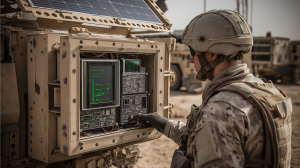Sustainable Defense Technology: Energy-Efficient HMI Design for Extended Missions
As military operations extend into remote regions for longer durations, energy efficiency has evolved from a convenience feature to a critical operational capability. Modern HMI systems must deliver maximum functionality while minimizing power consumption to support extended mission endurance and align with evolving Department of Defense sustainability initiatives.

The Power Challenge in Forward Operations
Extended military operations in remote locations face significant power generation and distribution challenges. Traditional generator-based power systems require substantial fuel logistics, create acoustic and thermal signatures that compromise operational security, and generate emissions that conflict with environmental stewardship goals.
Battery-powered systems offer tactical advantages through reduced signatures and enhanced mobility, but impose strict power budgets that demand careful optimization of every system component. HMI systems, which operate continuously throughout missions, represent significant opportunities for power savings through intelligent design approaches.
Display Technology Optimization
Advanced display technologies offer substantial power savings compared to traditional approaches. Modern OLED displays consume power only for illuminated pixels, providing significant efficiency advantages for applications that frequently display dark backgrounds or sparse information layouts.
E-ink and reflective display technologies eliminate backlight power requirements entirely for certain applications, enabling daylight-readable displays with power consumption measured in milliwatts rather than watts. Hybrid display approaches combine multiple technologies to optimize power consumption across varying operational conditions.
Intelligent brightness control algorithms automatically adjust display intensity based on ambient lighting conditions and user requirements, eliminating unnecessary power consumption while maintaining optimal readability. These systems can reduce display power consumption by 50% or more compared to static brightness approaches.
Processor Efficiency and Dynamic Scaling
Modern military HMI systems leverage advanced processor architectures that dynamically scale performance based on operational demands. During periods of low activity, processors automatically reduce clock speeds and voltage levels, dramatically decreasing power consumption while maintaining instant response capabilities.
Heterogeneous computing architectures combine general-purpose processors with specialized accelerators optimized for specific tasks. Graphics processing, signal analysis, and AI inference can be handled by dedicated hardware that delivers superior performance per watt compared to general-purpose alternatives.
Solar Integration Possibilities
Flexible solar panel technologies enable integration of renewable energy generation directly into military equipment without compromising operational capabilities. Modern high-efficiency photovoltaic cells can be integrated into equipment covers, antenna arrays, and even display bezels to provide supplemental power generation.
Advanced power management systems automatically balance solar generation, battery storage, and load requirements to optimize energy utilization throughout mission cycles. These systems can extend operational endurance significantly while reducing dependence on external power sources.
Power-Aware System Architecture
Energy-efficient HMI design extends beyond individual components to encompass entire system architectures. Power-aware software automatically adjusts system behavior based on available energy reserves, gradually reducing non-essential functions as battery levels decline while maintaining critical capabilities.
Intelligent sleep and wake algorithms ensure that system components consume power only when actively required. Advanced sensors can detect user presence and attention, automatically adjusting system power states to match operational requirements.
Lifecycle Environmental Impact
Sustainable design considerations extend throughout the entire system lifecycle, from material selection through end-of-life disposal. Advanced materials science enables the development of ruggedized components using recyclable materials without compromising performance or durability.
Modular system architectures enable component-level upgrades and repairs, extending overall system lifecycles while reducing waste generation. Standardized interfaces ensure that upgraded components can integrate seamlessly with existing systems, protecting previous investments while incorporating new capabilities.
Thermal Management Efficiency
Efficient thermal management systems reduce cooling power requirements while maintaining optimal component temperatures. Advanced heat sink designs, thermal interface materials, and intelligent fan control systems minimize cooling power consumption while ensuring reliable operation in extreme environments.
Predictive thermal management algorithms anticipate temperature changes based on operational patterns and environmental conditions, preemptively adjusting cooling systems to maintain optimal efficiency.
Mission Endurance Optimization
Power-efficient HMI systems enable extended mission durations without resupply requirements, providing significant tactical advantages in contested environments. Reduced power consumption translates directly to increased operational range and mission flexibility. Intelligent power management systems provide operators with real-time feedback on energy consumption and projected mission endurance, enabling informed decisions about system utilization and mission planning.
The Aeromaoz Sustainability Advantage
Aeromaoz‘s specialized focus on military applications enables us to implement sustainability measures that enhance rather than compromise operational effectiveness. Our deep understanding of military power requirements allows us to optimize energy efficiency without sacrificing the performance and reliability that mission success demands.
Our agile development processes enable rapid incorporation of emerging sustainable technologies while maintaining rigorous military qualification standards. This specialized expertise provides significant advantages in delivering environmentally responsible solutions that meet evolving DoD requirements.
Sustainable defense technology represents both an environmental imperative and an operational advantage. Energy-efficient HMI systems enhance mission capabilities while supporting broader sustainability goals, creating win-win solutions for military effectiveness and environmental stewardship.
